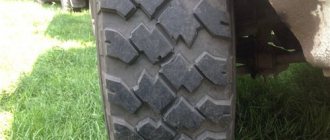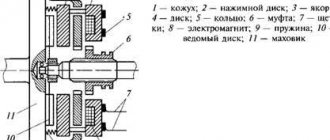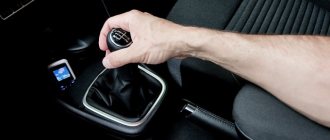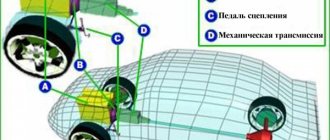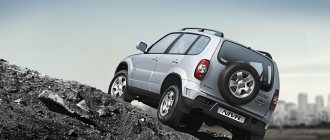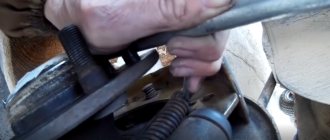How does a Niva transmission work?
Niva is a car that has been produced since 1977.
It differs from other domestic cars in that it has permanent all-wheel drive. Few car enthusiasts know what this means, although they have heard a lot about this feature of the vehicle; a diagram of the device can easily be found on the Internet. All-wheel drive in the Niva is equipped for all 4 wheels, and the center differential is locked. When the engine starts to rotate, an impulse is sent to the gearbox and transfer case, after which the torque is distributed to the front and rear axles simultaneously. Afterwards, the gearboxes are activated, and behind them the front and rear wheels of the Niva begin to rotate. Torque causes 4 wheels to rotate at once, which is why it is called full torque. But the rear wheels still drive.
https://www.youtube.com/watch?v=t1XX1XpmIzo
The VAZ 2121, in other words, “Niva”, entered mass production in the 70s of the last century. This car belongs to the class of off-road passenger cars. In the history of the domestic automobile industry, Niva became the first car whose design used all-wheel drive. Let's take a closer look at the transmission device.
The transmission in the Niva family (2121, 2131) is designed in such a way that all-wheel drive is supplied to 4 wheels. Also characteristic is the presence of a center differential. The transmission includes a gearbox, a transfer mechanism, a pair of cardan shafts, and both axles. A characteristic feature of the 2131 model is its elongated body.
Then it goes through the cardan shafts to the gearboxes. The front gearbox transmits torque to the wheels through the differential and constant velocity joints. Likewise for the rear, also protruding, driving wheels. It is precisely because the torque is distributed to 4 wheels simultaneously that the drive is called full drive. The designation is as follows – 4WD. Another domestic car, designed on a similar principle to the Niva, is the UAZ.
Knocking when starting off: causes and solution to the problem
Diagnosing a car yourself does not always give good results. Often it is simply impossible to find a complex problem without using the services of a service station. But there are situations when there is simply no time or opportunity to go to the service, and the cause of the problem must be found. This will help make sure that the car can be driven further without compromising the safety of the trip. A knock when starting off can be either a simple problem that can be solved on your own, or a serious problem with a lot of unpleasant consequences. Among the main reasons for such a knock are CV joints, gearboxes, loose wheel mounts and engine mounts. But this is not a complete list of possible problems with knocking in the engine compartment area.
Sometimes it happens that it is impossible to detect a knock from inside the car. You have to drive the car into a pit or overpass and examine all the details in the lower part of the engine compartment. Additional diagnostics of the chassis will not interfere with identifying the problem. First of all, you should check all kinds of fastenings. For example, a loose generator mount can easily cause a knocking noise when starting off or changing gears. A serious problem will be wheel bolts that are not fully tightened. In this case, you can break the entire chassis and lose a wheel while driving.
Fasteners and bolts - we look at many points regularly
You need to check the tightness of the wheel bolts regularly, because incorrectly tightened bolts can cause a lot of problems. But this is not the only reason for a possible knocking sound when starting off. If knocking sometimes accompanies gear changes, as well as sudden stops and acceleration, you should check the fastening of all parts of the engine compartment, including the engine. Problems can be hidden in quite unexpected places:
- if the fastening is broken, the generator begins to dangle and knock on the surrounding metal, while it does not give a charge;
- the starter and retractor relay may rattle if the fastening bolts are poorly tightened;
- The engine itself, if the mounting pad has burst or failed, may wobble and knock;
- the crankcase protection often causes knocking and cracking noises if one of the fastenings of this unit is torn off;
- a battery without fastening can easily wobble in free space, producing a knocking noise during a sharp start;
- Wheel fastening is a classic problem with such manifestations of a problem; they need to be checked constantly.
This list can be continued endlessly. During operation, any part can loosen its fastening and dangle, causing various troubles in the form of knocking and crackling noises when starting off. But solving this problem is often easier than ever. It is enough to check the fastenings of all the listed mechanisms and components and return everything to the required positions. The most difficult thing to restore is the engine mounts, but even this breakdown will not cost you a lot of money in repairs.
Gearbox - manual and automatic
Knocking and grinding noises can occur in any type of transmission. The mechanical type of gearbox often taps when the clutch and the box itself interact. When the discs are worn out, the contact occurs quite hard. Also, a knock may be present if the main pair of the gearbox is missing one or more teeth. With an automatic transmission, everything is much more complicated. If there is a knocking or constant humming noise on the machine when starting, you will have to perform the following difficult processes:
- dismantle and disassemble the gearbox at a service station; only with the help of professionals can the problem be solved;
- identify faulty modules (often the culprits for knocking will be gearbox satellites);
- find the necessary original spare parts for automatic transmission repair and restoration of its former capabilities;
- install all found parts professionally in compliance with factory requirements for fastenings;
- test the operation of the box and finally assemble the power unit to its former state;
- carry out tests and make sure that knocking noises from the gearbox will no longer irritate the owner.
This is a difficult and often expensive process that will have to be carried out when repairing an automatic transmission. But the mechanics in this case will not allow you to relax. Dismantling the box, purchasing the main pair and, possibly, gears and forks of other gears, as well as paying for the repair process - all this will cause excessive costs during the repair work. But without this procedure, the box will not be able to function normally.
Causes
According to the official statement of the manufacturer, all-wheel drive Chevrolet Niva, a little noise is allowed even in the absence of malfunctions. This is due to the fact that the gear clutches of the transfer case, gearbox and drive shafts are made taking into account thermal clearances. The size of the latter takes into account manufacturing tolerances and the coefficient of thermal expansion of materials. Knocks and noises when starting off and changing gears are caused by insufficiently smooth engagement of the clutch.
However, gaps are not the only cause of knocking. They occur when gears, bearings and transmission shafts wear out. Axles with gearboxes also make a lot of noise when the level of transmission oil in the crankcase is insufficient.
Problems with the chassis are characterized by the following malfunctions:
- noise when driving or rotating wheels
- difficulty shifting gears
- disabling the selected gear, spontaneous transition to neutral
- oil drips
On some cars, problems may appear in the first 5-10 thousand kilometers in the form of knocking in the transmission. The main types of problems are given in table form:
In rare cases, the problem may be due to a faulty linkage. This is the main unit that provides communication between the transmission and the rod that transmits rotation to the box.
How to enable differential lock on Niva
The Niva and its various modifications allow you to operate 3 differentials at once. Thanks to this factor, the vehicle’s cross-country ability increases significantly when driving in rural areas. The forced locking format involves connecting the driving wheels together, causing them to spin at different speeds. This approach allows you to use the maximum possible traction characteristics of the engine, which are transmitted to the wheels.
To lock the differential on the Niva, the manufacturer has provided a clutch for the locker. When forced locking is turned on, the wheels become interconnected and rotate in the same mode. When the inter-axle lock is activated, the axles located at the front and rear interact and distribute traction to all wheels. This mechanism is easy to use, which is confirmed by the unique cross-country ability of the Chevrolet Niva.
How to fix it?
To properly move off a Chevrolet Niva, you have to “catch the clutch” twice to select the gap: when starting the car from a standstill and when changing gears. The work of both legs is important here. You need to release the clutch as slowly as possible while simultaneously squeezing the accelerator.
When bearings and gears wear out, play occurs, which cannot be compensated for by smooth operation of the pedals. In this case, it is necessary to replace the worn parts as soon as possible, before the knocking noise when changing gears of the Chevrolet Niva causes serious damage.
The same applies to noise caused by a lack of oil in the crankcase of axles and gearboxes. Operation of these components without lubrication is not allowed.
Suspension diagnostics.
From time to time, a knocking sound may appear in the front suspension of the Niva Chevrolet. If this problem occurs, it is necessary to immediately diagnose it. It starts with a visual inspection. It is best to do it on a lift or inspection ditch. The wheels must be hung to be able to check the play of the parts. First of all, rubber parts are checked - anthers and oil seals. They should not have visible mechanical damage, cracks or other signs of aging. It is also necessary to check that rubber-metal products do not have one-sided bulging of the mass or its separation from the reinforcement. In this case, it is necessary to immediately replace the parts.
After this, the protective covers on the balls are checked. They are non-separable, so if there is damage, it is necessary to replace the complete structure.
Particular attention should be paid to the cushions that are located between the hinges and the rubber bushings of the shock absorbers.
After this, the front levers of the Niva Chevrolet are inspected. They are held in place by bushings, which wear out over time.
When to use and how to disable blocking
It is preferable to enable forced blocking in various modifications of the Niva in the following situations:
- The blocking must be turned on in advance if you have to overcome a difficult route.
- On sharp climbs uphill or when driving downhill.
- While crossing terrain with a top layer of sand.
- When you have to drive on snow drifts or an icy road.
Wheel locking is not necessary when driving quietly on a flat road within the city. Grip on asphalt surfaces will be decent, and traction will be distributed evenly by default.
Useful video
To use the lock installed on the Niva effectively, use the following recommendations from experts:
- When driving on good quality road surfaces, install the front transfer handle at the front and the rear at the rear.
- The front handle is moved back if the road becomes slippery. Once the slippery area has been passed, switch the levers to normal mode.
- If the Niva is stopped, the lock may not engage when the clutch is depressed. This occurs due to the alignment of the teeth with the gear teeth. What should you do in this case? Moving as if on a turn, engage the lock. The differential will turn and the gear teeth will come closer to the teeth. If turning off is difficult, do it while the vehicle is moving, maintaining a minimum speed and squeezing the clutch.
Also interesting: Blue silicone stove pipes for Lada Niva 21214 injector | Motorring online store
Clutch and gearbox
These units do not differ from the predecessor Lada 4*4 and come in the same housing. The clutch is a dry type, rotation from the flywheel is transmitted through the driven disk to the sprockets of the variable gearbox.
The gearbox is 5-speed, another important difference from the classic Niva is the mounting under the car body and an extended gear shift drive.
Frequent malfunctions are leakage of gearbox seals, so the gearbox body must be carefully inspected for leaks. If the replacement is not carried out in time, due to oil starvation, the 5th gear, located above the other sprockets, will wear out first.
The 2123 clutch is quite durable, but it is better to trust proven imported brands.
Rules for applying blocking on Niva
To ensure that the locking mechanism lasts for a long time, use the following rules:
- It is necessary to switch the transfer case when the Niva does not move.
- The differential can also be engaged while the vehicle is moving.
- To ensure efficient and long-term operation of the device, it is advisable for the Niva driver to turn on the lock from time to time. Once a week in winter is enough.
Where is the lever responsible for switching located? Pay attention to the area between the wings located in front, there are 2 levers there. One makes it possible to change gears at the gearbox, the other successfully controls the transfer case.
The basis of the transfer case is a gearbox, which includes 2 stages. The control lever comes directly from it, you can move it forward and backward - this is how the gear is changed on the Niva. The direction of movement of the lever to the left and right allows you to activate the differential lock and vice versa to disable it.
This problem can be identified by several signs:
- large play in the shift lever
- difficulty shifting gears
- difficulty adjusting the mechanism
If these malfunctions appear during gear shifting and, in addition to the above symptoms, lead to erroneous gear shifting, then you should try to adjust the transmission drive.
Some problems may be associated with failure of the clutch mechanism. They usually appear in the form of jerks at the moment of movement. In this case, a complete replacement of the clutch basket may usually be necessary.
When checking the clutch, it is important to pay attention to all the details of this mechanism. Because when one element fails, rapid wear of adjacent nodes usually occurs.
If there is a knocking noise in the transmission while driving, this may indicate an imminent repair. This should not be delayed, as this is an important component of the car, which is directly related to the safety of the driver and passengers.
Why is downshift needed?
It is difficult to imagine a transfer case without the main functional component - a reduction gearbox. Positioning the lever in the rear direction reduces the transfer case value to 1.2.
By fixing the lever at the front, the gear ratio can be increased to 2.1. The lever in neutral indicates gear ratio 0.
You can often encounter the following type of misconception: switching the rear handle can increase the power characteristics of the motor. But this is not true. It serves to change the gear ratio between the engine and the wheels. By increasing it, the traction forces on the wheels will increase. There is also a reduction gear in the dispensing mechanism.
DON'T SPEND MONEY ON REPAINTING! Now you can remove any scratch from the body of your car in just 5 seconds.
Its operation can be controlled using the rear handle. When we shift the lever back, we will have a gear ratio of 2.135 - this is a low gear. It is recommended to downshift such a gear only when the car is stationary and the clutch is depressed. Despite the fact that the manual does not contain such a restriction, novice and inexperienced Niva drivers are not recommended to switch while driving, since the Niva transfer mechanism is not equipped with a synchronizer.
Causes of knocking in the rear suspension area
Rear suspension malfunctions are also accompanied by various sounds. But, before you start searching for them, it is necessary to inspect the muffler mounts, since this element is often the source of various noises in the rear of the car.
The first step is to check the performance of the shock absorbers, since their malfunction often causes a knock in the rear suspension. This is done by analogy with the front
In addition, during the diagnostic process, attention should be paid to their fastenings, since weak nut tightening is the source of many problems
After this, it is necessary to check the springs, rubber shock absorber inserts, silent blocks, hubs and their bearings, and parts of the brake system.
As you can see, the process of diagnosing the elements of a car’s chassis is not particularly complicated. To perform it, you don’t need a set of special tools, except that an inspection hole will come in handy, and the help of a friend won’t hurt. Therefore, you should not ignore its implementation, since this measure will help avoid most problems, and in certain situations, save someone’s life.
Differential locking
Sometimes you can come across a misconception about why a small handle is needed next to the shift lever on a Niva. Some car owners believe that it is needed to connect front-wheel drive. However, the front-wheel drive of this car is permanently connected. As is the rear one. Cars of the Niva family have permanent all-wheel drive. The handle actually serves to switch the operating modes of the differential of the transfer mechanism.
In the “forward” position, the differential operates as usual, but if you move it back, the differential is locked, and the forces from the motor are applied to the differentials of the axles, which makes the drive more rigid. It is worth noting that there are also special types of locks for front and rear axles.
In theory, when used in conditions where the car is stuck, it will be able to overcome the obstacle if there is sufficient traction on at least one wheel. In this case, it is better to lock the differential before overcoming an obstacle, but never after entering an area that is difficult to overcome. This application of locking will avoid wear and damage to the transmission.
Knocks in the suspension and transmission of Chevrolet Niva
If extraneous knocking noises appear in the suspension of a moving vehicle, it is necessary to immediately determine their source, regardless of whether the knocking is constant or appears only when driving over uneven surfaces.
WARNING Faults in the vehicle's suspension and steering can lead to a serious accident!
USEFUL ADVICE It is better to check the condition of the suspension by placing the car on an overpass, inspection ditch or lift, and if this is not possible, you can do this work on a free flat area, although with less convenience. In any case, you will need an assistant.
Start your check by carefully inspecting the condition of the suspension parts.
1. Check the condition of the rubber-metal hinges of the lower...
2. ...and the upper front suspension arms...
3. ... rubber bushings of the stabilizer bar and the reliability of fastening their brackets.
4. Carefully inspect the suspension arms. Cracks and mechanical damage to the levers, especially at the attachment points of the ball joints, are unacceptable.
5. Check the reliability of fastening and the condition of the upper cushion and...
6. ...lower mounting of front and...
7. ...rear shock absorbers. Replace cushions and bushings with rubber that is torn, cracked, or pressed out on one side.
8. Check the wear of the ball joints...
9. ...and front suspension supports.
10. To check the hinges, lift the front wheel with a jack (or hang the car on a lift, placing a support under the lower arm and lowering the car slightly to unload the hinges).
11. Rock the wheel in a vertical plane, with an assistant pressing the brake pedal to eliminate possible play in the hub bearings. If play is felt (the upper outer edge of the brake caliper moves more than 0.5 mm; this distance can be measured, for example, using an indicator), it means that the hinges are worn out, they may make a knock when driving over uneven surfaces and need to be replaced.
12. Rock the wheel in a vertical plane, holding the top with one hand and the bottom of the wheel with the other while releasing the brake pedal. Increased knocking from the central part of the wheel indicates a large gap in the hub bearing.
13
When checking the rear suspension, pay attention to the condition of the hub bearings, shock absorbers, springs, longitudinal and transverse rods and the fastenings of the shock absorber rods to the body. Carefully inspect the rear axle crossbar bracket on the body
USEFUL TIPS After replacing individual parts of the front suspension, it is necessary to check and adjust the alignment angles of the front wheels. This operation must be carried out on a special stand in a car service center, since incorrect installation of wheels leads to increased tire wear, increased fuel consumption and deterioration of vehicle stability and controllability.
Pay attention to the exhaust system. Very often, due to the use of non-standard elements or breakage of the muffler suspension elements, it can be a source of strong knocking, especially when changing the throttle
To check, stop the engine, carefully inspect the exhaust system, check the reliability of the muffler fastening and suspension. Holding the end of the exhaust pipe, rock the muffler up and down and from side to side - there should be no knocking.
Knock (noise) in the cardan transmission
It is quite difficult to diagnose the serviceability of the cardan transmission by the noise it produces. If you are unable to pinpoint the source of the noise, contact a qualified professional.
Knock (noise) in the rear axle
It is quite difficult to diagnose the health of the rear axle based on the noise it makes. If you are unable to pinpoint the source of the noise, contact a qualified professional.
Knock (noise) in the front axle
It is quite difficult to diagnose the health of the front axle based on the noise it makes. If you are unable to pinpoint the source of the noise, contact a qualified professional.
Tips for owners
To make driving your car comfortable, read some important points:
- The usual, standard arrangement of the front and rear handles is forward and backward, respectively. Movement in this mode can and should be carried out in areas characterized by even and smooth surfaces.
- Locking the differential by switching the front handle to the rear position is best on roads characterized by increased slipperiness. This measure will give Niva stability. It is worth understanding that after overcoming the problem area, the handle will need to be returned to its original position.
- As noted earlier, downshift should be activated before a potential obstacle, but not while the car is already stuck.
- It is worth understanding that activating the lock when the vehicle is stationary is sometimes impossible, even if the clutch is depressed. This may be caused by the clutch teeth hitting the gear teeth. In this case, you can try to activate the lock by starting to drive slowly and make a slight turn. If problems arise with disabling the lock, it is recommended to perform the same procedure with the clutch depressed and the steering wheel slightly rocked.
Also interesting: Transfer case Niva 2121: principle of operation, repair
A car with an automatic transmission jerks when driving
Car diagnostics were not invented to suck money out of unknowing car enthusiasts - first of all, it is an opportunity to identify upcoming breakdowns and eliminate their occurrence before the car has to be “hospitalized.”
If a car with an automatic transmission jerks when driving, then the first reason may indeed be hidden in the low air temperature. This occurs due to freezing (thickening) of the oil; preheating will save the car.
Your car may be jerking because it simply doesn't have enough oil. Check its level, it is possible that the reason lies there.
The third reason also lies in the oil. Remember the last time it was changed. Regular replacement will help avoid many problems in car operation.
How to use a transfer case in a field, box design
The relatively complex scheme for distributing torque from the internal combustion engine to the wheels is explained by the universal purpose of the Niva 2121 - if used correctly, it can be used comfortably in the city and along muddy country roads. Such properties are ensured by the presence of a transfer case with a center differential lock, complementing a 4- or 5-speed manual transmission, depending on the year of manufacture.
The normal position for the RK handles, ensuring adequate behavior on the road of good quality:
- Front - from yourself
- Rear - towards you
The special operating mode of the transmission is switched on not long before the car begins to overcome an obstacle (rut, mud, ford or rise). The transition to the lowest row must be done while stopping. Returning to top gear is allowed on the go, although it causes problems for beginners due to the lack of the usual synchronizer.
It is somewhat more difficult to properly handle the forced manual locking of the center differential. On the contrary, it turns on when the car moves slightly (up to 20 km/h) due to misalignment of the grooves on the locking clutch, satellites and ring gear. To simplify turning the lever into the desired position, taking into account the Niva 2121 transfer case, pick up a small speed, then, shaking the steering wheel, pull the handle towards you.
Problems can also arise when disengaging the lockout, as the clutch teeth literally catch on the ring gear. Engage reverse and, rocking the steering wheel, push the lever away from you. This action is performed immediately after overcoming a difficult section in order to avoid overloading the gearbox. It is most effective to disable the differential together with the transition to lower stages.
Niva Chevrolet knocking noise when switching, how to fix it? – CARRU Tyumen Car Enthusiasts Portal Tyumen
I almost agree. And even further - I washed out its CV joint and the gearing in the transfer case between the primary, intermediate and differential, aka the coupled output shafts. In general, it was this area that I wanted to check by locking the differential. What happens if the lock is turned on when the car is completely stopped? IMHO the gaps should remain. As soon as movement begins, backlash will be released due to internal stresses in the transmission.
And the Chevrolet Niva itself will have backlash in the transmission differently than when the lock is turned off.
It's clear. Nice idea: This can happen even on new machines. Moreover, such a problem is not a warranty case.
Therefore, you will have to fix the problem yourself. The problem appears due to play in the transfer case, as well as near it.
Usually this noise is produced by several parts. To fix the problem you will have to tinker. First, you need to check the transfer case mounting. Sometimes a knocking noise can be caused by simply unscrewing the transfer case.
backlash in Chevrolet Niva transmission
This often happens on new cars, as well as after removing the box during repairs. In this case, simply tighten the screws.
Be sure to check for any play in the cardan. Sometimes the connection can wear out and rattle. Here the repair is more serious; the cardan may have to be replaced. The knocking noise can also be caused by wear of parts inside the transfer case. This is the most difficult case.
It is very difficult to do a complete overhaul of the box without experience. Other problems In fact, the Chevrolet Niva transfer case is not very reliable. For the owner of a Chevrolet Niva, play in the car's transmission can be accompanied by many different breakdowns. Knocking is far from the only cause for concern. Let's look at all the main symptoms of a malfunction, as well as ways to eliminate them, in more detail.
Often similar signs appear when other parts wear out. Sometimes there may be a persistent vibration of the floor, as well as the chairs. This happens in all driving modes. The problem is the elasticity of the transfer case clutch.
This is due to the low-quality rubber from which it is made. Due to temperature changes, the coupling cracks and loses its properties. This problem is treated by installing a new part.
The device of the VAZ Niva transfer case
The transfer case mechanism includes more than 60 independent parts, which is confirmed by the presented drawing. Therefore, it is quite prudent to name the main elements and their purpose.
- Frame
- Differential housing
- Shafts
- Couplings
- Oil seals
- Satellites
- Gears
- Flanges
- Levers
A pair of gears are tightly seated on the drive shaft, one of them (large) is intended for high gear, the second (small) is responsible for low gear. They have serrations with straight and oblique profiles. The first ones are in contact with the coupling, the second ones - with the intermediate shaft. The inclusion of one or another row causes the coupling to move along the hub in the horizontal direction, after which it is connected to the gear on the transfer case drive shaft.
The intermediate position turns off the gearbox (the gearbox is open), and the vehicle cannot be moved in this mode. The front helical gear on the intermediate shaft is used to control the differential. The locking is engaged, or the rigid coupling of the drive shafts of both axles, is carried out through a clutch. The design is typical for modifications 21213 and 21214, and the latter is additionally equipped with a speed sensor drive.
In the operating state (with the transfer case reduction gear connected), the gear ratio in the first stage changes from 4.4 to 7.83, the second - from 2.52 to 4.58, the third - from 1.63 to 2.9, in the fourth - from 1.2 to 2.14, fifth - from 0.98 to 1.75, which is expressed in an increase in traction on the wheels.
The transfer case is not present in all VAZ passenger cars, but only on cars with two drive axles. In the transmission, the transfer case (TC) is installed at the rear of the gearbox; a rear driveshaft is attached to its shank, which connects the transfer case to the rear axle. The front axle is also driven by the steering wheel; it is connected to the transfer case by a front driveshaft.
The reduction gear in the Republic of Kazakhstan is designed to obtain high torque, it is used to overcome difficult sections of the road, and helps to cope with off-road conditions. The VAZ Niva transfer case contains the following main parts:
- the body itself;
- front axle drive shaft;
- intermediate shaft;
- drive shaft;
- gears;
- bearings;
- differential housing;
- satellites;
- differential lock clutch;
- gear shift clutch;
- flanges (for connection to cardan shafts);
- oil seals;
- control levers.
Chevrolet Niva gearbox howl
Chevy Niva Gearbox noise
The hum of the bearing of the input shaft of the Niva/Shniva gearbox
Gearbox noise on Niva
why is the checkpoint howling?
How to determine whether the transfer case or gearbox of a VAZ 2121 NIVA is noisy.
Rumble in RK Niva Chevrolet
Chevrolet Niva Vibration. Checking the leak. 3rd support. Vibration of Chevrolet Niva transfer case. Causes
NIVA CHEVROLET — repair of manual transmission and gearbox
Cause of noise in Niva Chevrolet?
Noise howl whistle Chevrolet Niva 1
I would like to say right away that I have already read many topics on the forum on similar topics - there are different opinions everywhere. Some people talk about poor wheel balancing, some about bad cardan shafts, some about the transfer case. I'm not bothered by hum or low-frequency vibration, so the wheels and driveshafts have nothing to do with it, the sound that I don't like is a high-pitched howl, not loud, it manifests itself even when driving slowly in 2nd gear, as well as at speeds of 50-60. As speed increases, the sound intensity increases, although it is partially covered by engine operation and tire noise.
I have a question about the transfer case - does everyone have it howling? Should she howl? I was so sick of this howling that I decided to replace the transfer case. I ordered it at the store and they brought it new from the factory. I installed it at the service center so that the warranty on it was preserved. In addition, I immediately changed the universal joints to Belkard ones, since the original curves were there. I also changed the oil at the same time (the time has come) in the entire transmission, well, except for the transfer case - the factory run-in oil was filled in there.
So, the vibration seems to have decreased, although the rear one still gives a slight low-frequency vibration. But the howl has not gone away. I arrived at the store and filed a claim with them. They drove with me and said – the transfer case is fine, it’s your gearbox that’s howling. Okay, I'm going to the foreman who is going through the boxes. He listened and said: the gearbox doesn’t howl like that, maybe the front axle gearbox. We need to do an experiment - remove the front driveshaft and listen while driving. If RPM, then the howling will disappear. Removed. Didn’t disappear Well then, he says, it’s a handout. But they all howl, so forget it. And I’m offended - a new transfer case, 10 thousand rubles, but the effect is zero! The howl is on a high note, so it gets into your ears, although it’s not loud. True, as the speed increases, it intensifies a little, but at the same time, the noise of the engine and wheels partially covers it. But since I mostly drive around the city, the howl is clearly audible when driving at a speed of 50-60 km.
Possible problems
Harsh operation and insufficient attention to how to use the transfer case on the Niva 2121 lead to the appearance of:
- Vibrations in the body while driving
- Vibrations at start
- Gula
- Noise when maneuvering
- Tight switching modes
Experience shows that the culprits are: insufficient oil level, incorrect centering of the steering wheel, loosening of the support fastenings and damage to the rubber bands. An additional influence is exerted by the condition of the cardan and the engine itself.
Features of transfer case Niva 2121, VAZ 2131, Lada 4x4
The Niva 2121 transfer case is used to change the amount of torque and distribute it between the front and rear axles. The box has two gears with ratios of 1.200 and 2.135. The front and rear axles are constantly driven and connected by a center differential, which redistributes torque between them depending on the resistance to wheel movement.
The Niva 2131 transfer case is attached to the body floor on two rubber-metal brackets. To adjust its position relative to the intermediate shaft flange, the holes in the brackets are made oval, and adjusting shims can be installed between them and the body. The procedure for centering the box is described in the section Determining the causes of vibration and centering the transfer case.
Also interesting: How to properly use the transfer case on Niva 2121
The housing parts of the transfer case are cast from aluminum alloy and are connected to each other with studs and nuts. There is a hatch in the upper part of the crankcase, closed with a stamped steel cover. The front cover is centered on the crankcase using two locating pins. There are cardboard gaskets between the covers and the crankcase (during repairs, you can use a sealant gasket instead).
The drive shaft is mounted on two ball bearings in the sockets of the front cover and crankcase. The front bearing inner race is sandwiched between the shaft shoulder and the thrust ring by a self-locking shaft flange nut. The rear bearing inner race is sandwiched between the shaft shoulder and the thrust washer by a nut at the rear end of the shaft.
There are two drive gears on the drive shaft. The front (large) is the highest gear; it rotates freely on a heat-treated shaft journal. The rear (smaller) gear - the lowest gear - rotates freely on a heat-treated bushing mounted on the shaft with tension. The gears have two crowns. The helical (large) rings are in constant mesh with the corresponding gears of the intermediate shaft, and the gear shift clutch is connected to the spur (small) gears when the gear is engaged.
The Niva 2131 intermediate shaft is a block of two helical gears that are in constant mesh with the drive shaft gears. The front gear is also in mesh with the driven gear mounted on the differential housing.
The intermediate shaft rotates in two bearings: the front one is roller, the rear one is ball bearings. The shaft is secured against axial displacement by an adjusting ring in the groove of the outer ring of the rear bearing, which is sandwiched between the crankcase and the rear cover (the same as that of the drive shaft). A steel drive gear for the speedometer drive is pressed into the front end of the shaft.
On a VAZ-21214 car with distributed fuel injection, in addition to the mechanical speedometer drive, a speed sensor is installed on the transfer case.
The front end of the drive shaft of the Niva 2121 front axle rests on a ball bearing in the front axle drive housing, mounted on the front cover of the transfer case. The inner ring of the bearing is sandwiched between the shaft shoulder and the thrust ring by a self-locking shaft flange nut. The bearing is secured against axial displacement by a retaining ring that fits into a groove in the front axle drive housing.
The differential housing is detachable, both parts are connected by six bolts. The same bolts also secure the driven gear to the differential housing. The latter is mounted on two ball bearings. The inner race of the front bearing is held from displacement by a spacer spring washer resting on a retaining ring in a groove in the differential housing.
The groove on the outer bearing race includes a mounting ring, sandwiched between the transfer case front cover and the front axle drive housing. Thus, the differential housing is held against axial displacement by the front bearing; the rear bearing is not fixed. The front of the differential housing has splines along which the locking clutch moves. When the lock is engaged, the clutch is connected to the gear on the front axle drive shaft, connecting it to the differential housing.
In the holes of the differential housing of the VAZ 2121 there is an axis of the satellites, held by two retaining rings. Under one of the rings there is a spring washer that prevents axial movement of the satellite axis. The satellites (bevel gears) located on the axle are in constant mesh with the axle drive gears.
The transfer case control is manual, with a mechanical lever drive. The driver uses the rear lever to change gears, and the front lever to engage the differential lock. The design of the gearbox control drives is similar. The lever swings in the longitudinal direction on an axis installed in the bracket eyes in front of the Niva 2131 transfer case.
To reduce friction, plastic bushings are inserted into the hole in the lever. The lower end of the lever fits into the groove of the rod and is fixed with a figured spring. The other end of the rod is connected to the fork of the corresponding clutch (gear shift or differential lock) and is secured with a bolt. The rod at the exit from the box is sealed with an oil seal and protected from dust by a rubber corrugated cover.
To fix the drive in the selected position, a ball lock is used - a spring-loaded ball fits into the grooves on the rods. There are three of them on the gear shift rod - for “neutral”, high and low gears; on the differential lock rod of the VAZ 2131 there are two (“on” and “off”). A switch is screwed into the front axle drive cover, which closes the warning lamp circuit when the differential lock is engaged.
Read news about the new Niva
- All-terrain vehicle fracture 4x4: photo of step-by-step assembly video of a trip on an all-terrain vehicle
- Homemade all-terrain vehicle on low-pressure tires (45 photos)
- Dismantling and assembling the gearbox Niva 2121, Niva 2131
- Nissan engine on a Niva – Replacing a Niva engine with a Japanese one
- FROST car air conditioners // Online store // Prices // Air conditioners for cars Lada VAZ, VolksWagen Polo, Daewoo Matiz
- Transfer case Niva VAZ - do-it-yourself repair and replacement
- Transfer case Niva 2121: principle of operation, repair
- Gearbox VAZ-21213 Lada Niva, VAZ-21214 Lada 4x4, diagram
AvtoVAZ explained what to do in case of vibrations and jerks when starting a LADA car
12 May 2022 LadaOnline 96 604
Some owners of Lada Priora, Granta, Kalina or Vesta cars experience vibrations and jerking when starting to move (the car jerks). One of the reasons for this malfunction may be in the clutch. How to act in the event of such cases is indicated in the AvtoVAZ information letter.
Information letter No. 5-17 dated 01/23/17
When owners of LADA cars of the KALINA, GRANTA, PRIORA, VESTA families, equipped with a 1.6 liter engine and gearboxes 2180/2181/2182, complained about “Vibrations, jerking when starting the car”
Carry out diagnostics according to the attached methodology, Appendix 1.
If you need to replace the clutch kit:
- If the vehicle is equipped with a driven clutch disc 21703-1601130-30
, in the absence of violation of operating rules, replace the clutch kit under warranty with: pressure plate
21703-1601085-30
, driven disc
21703-1601130-31
; - If the vehicle is equipped with a driven clutch disc 21703-1601130-31
(standard installed only on LADA VESTA GFL120 (KP 21827) vehicles) or a driven clutch disc
21703-1601130-32
(standard installed only on LADA VESTA vehicles GFL110 (KP 21807)) it is necessary to draw up a CLO with a description of the work performed and act in accordance with the recommendations received in response to the CLO.
Fill out the AGO for the work performed with a description of the reasons for the non-compliance and using the defect code, 1601130-051-001 “Vibration, jerking when starting a car with AMT”
, with attachment of a photo of error codes or 0
“Vehicle vibration when starting off”
, depending on the vehicle configuration, defective part 1601130, labor intensity item in accordance with the current collection of labor intensity.
Diagnostic technique
Methodology for diagnosing a car and eliminating the defect notes “Vibration, jerking when starting the car”:
1.
Test drive to confirm the defect. Is the defect confirmed?
- YES - go to step 2:
- NO - no repair work is required.
2.
Checking for the presence of fault codes in the ECM and KURKP. Are there any fault codes?
- YES - eliminate the causes of their occurrence in accordance with the relevant technical specifications, and then proceed to step 1;
- NO - go to step 3.
3.
Are there any comments on the stability of the engine at idle and low speeds?
- YES - eliminate the comment and go to step 1;
- NO - go to step 4.
4.
Are there any leaks of working fluids (oil, coolant) in the gearbox area? Was there a risk of getting caught in the clutch?
- YES - eliminate the causes of their occurrence and go to step 5;
- NO - go to step 6.
5.
Remove the clutch. Are there any signs of oil and/or coolant on the clutch friction surfaces?
- YES - replace the clutch kit and wipe the flywheel with acetone/degreaser to remove oil and/or coolant;
- NO - go to step 6.
6.
Are there any damage to the power unit mounts?
- YES - eliminate the comments and go to step 1;
- NO - go to step 7.
7.
Are the tightening torques of the power unit mounting bolts adequate?
- YES - go to step 8;
- NO - reach the required values and go to step 1.
8.
Are the tightening torques of the bolts of the belt securing the gearbox to the engine maintained?
- YES - if there are no violations of the operating rules, replace the clutch kit;
- NO - reach the required values and go to step 1.
Note: the most obvious starting mode in which vibration appears is smooth starting on small slopes. At the same time, when starting, you must not allow the engine speed to drop below idle speed.
Let us remind you that you can determine which transmission is installed on a Lada Vesta car by the values from the fourth digit of the VIN code (GFL11 - VAZ manual transmission; GFL12 - AMT; GFL13 - Renault manual transmission).
By the way, we have already described how the clutch is replaced under warranty, as well as other AvtoVAZ regulations.
Keywords: Lada Vesta clutch | clutch Lada Kalina | Lada Granta clutch | Lada Priora clutch | gearbox Lada Vesta | gearbox Lada Kalina | gearbox Lada Granta | gearbox Lada Priora | AvtoVAZ order
6 0
Found an error? Select it and press Ctrl+Enter..
About improved clutch discs for Lada Vesta and XRAY What kind of clutch is on the Lada Vesta and XRAY and what are the reviews about it Clutch of Lada Granta, Kalina, Priora and its possible malfunctions
